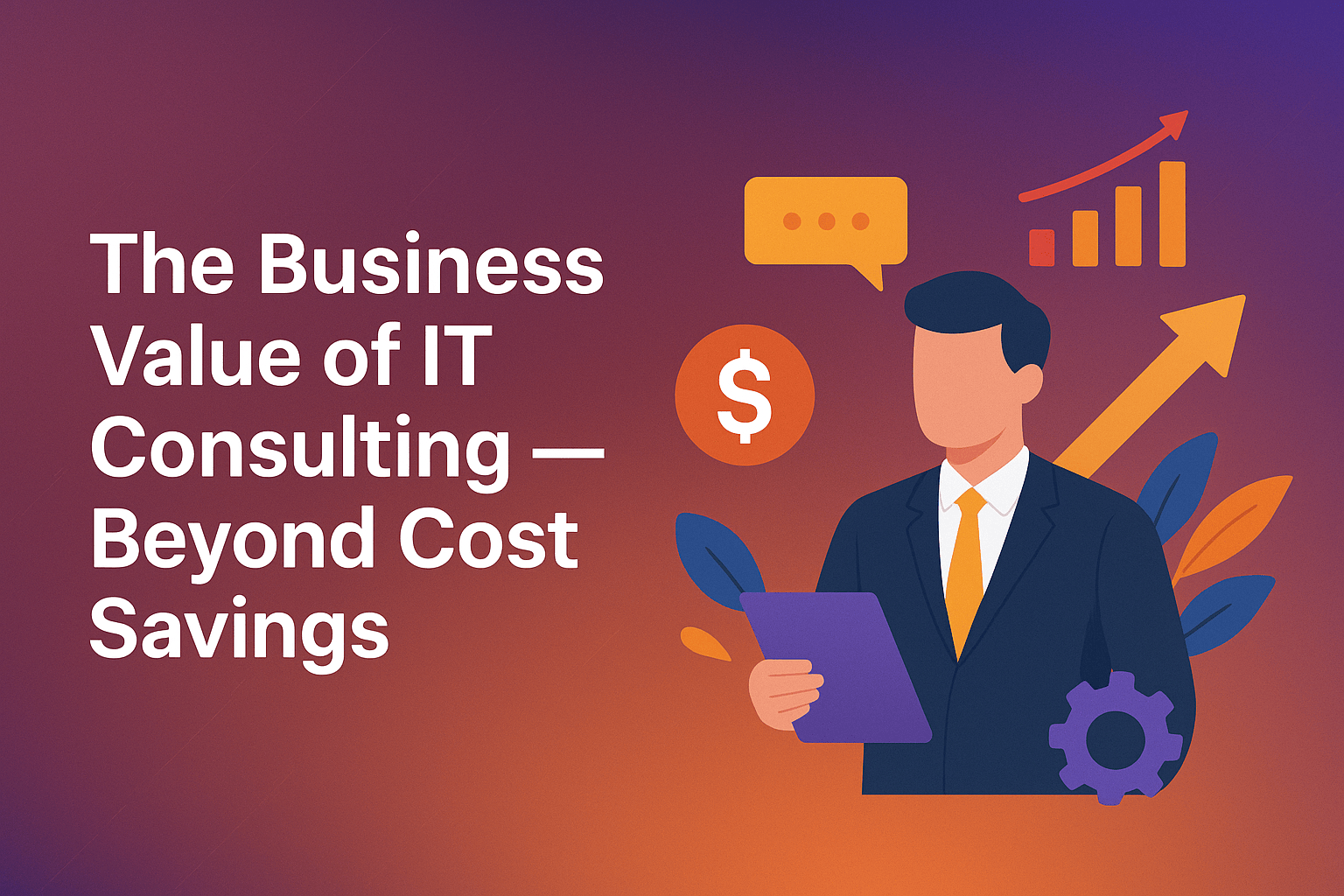Introduction — Why “More Than Cost Cuts” Matters
When organizations hire IT consultants, the immediate expectation is often cost optimization: reduce vendor spend, consolidate platforms, or cut headcount. That’s real value, but it’s only the start. Today’s IT consulting delivers strategic outcomes that directly affect revenue growth, speed-to-market, customer experience, risk reduction, and long-term resilience. Framing consulting as purely a cost play shortchanges the broader — and often larger — business impact consultants deliver.
1) Accelerating Time-to-Market and Revenue Opportunities
A core contribution of IT consulting is speeding product and feature delivery. Consultants bring battle-tested delivery models, staged roadmaps, and a blend of strategy + technical delivery that reduces rework and shortens project cycles. McKinsey’s research on digital rewiring shows that structured transformations (strategy → capability → delivery) create measurable bottom-line gains — not just savings. When organizations shorten release cycles, they capture market windows faster and can generate incremental revenue from early feature launches.
Deloitte’s research indicates many organizations dedicate roughly 7–8% of revenue to digital transformation, emphasizing that digital spend is strategically targeted at growth and capability — not just cost cutting.
2) Enabling Innovation & New Business Models
IT consultants often act as the connective tissue between C-suite strategy and engineering execution — helping firms pilot and scale innovation safely. For instance, Forrester Total Economic Impact (TEI) studies regularly show that platforms and tooling recommended by consultants can deliver high ROI through faster innovation throughput, improved product success rates, or new revenue streams. This is where consulting creates portfolio value: turning technology investments into repeatable, monetizable capabilities.
A client that modernizes its data platform with consulting help can launch personalized services or tiered offerings that were previously impossible — turning infrastructure spend into new, recurring revenue.
3) Improving Operational Resilience and Reducing Business Risk
Beyond speed and growth, consulting provides structured risk-reduction benefits. Consultants help organizations design resilient architectures, enforce best-practice governance, and run disaster-recovery exercises that lower the chance and impact of outages. McKinsey and PwC both highlight that digital transformations that include resilience and governance elements reduce operational risk and protect revenue streams over time. In regulated industries (finance, healthcare), this risk reduction translates directly into avoided fines, litigation, and reputational loss.
Industry transformation frameworks (e.g., PwC’s digital value transformation) emphasize measurable outcomes — not just cutbacks — showing that structured transformation increases the fraction of projects that realize enterprise value.
4) Raising Organizational Capability — People, Processes & Tools
Consultants don’t just deliver artifacts: they transfer capability. Effective engagements upskill internal teams, introduce repeatable delivery patterns (CI/CD, SRE practices, data governance), and institutionalize metrics. This capability uplift reduces future reliance on external help and increases velocity across IT. Accenture, Deloitte and the major consultancies increasingly measure success by the client’s ability to sustain and extend outcomes after the engagement — a shift from one-off projects to capability building.
5) Improving Customer Experience & Competitive Differentiation
IT consulting helps companies reimagine customer journeys by combining tech, data, and design. By aligning IT strategy with customer insights, consultants help launch features and services that improve retention, conversion and lifetime value. McKinsey’s work on “rewiring for value” shows digital-first firms who pair product capability with operational change capture disproportionate customer and revenue gains. In short: IT consulting can be an engine for CX transformation that drives business outcomes.
6) Demonstrable ROI — How Consulting Outcomes are Measured
To shift perception from “cost center” to “value partner,” organizations should measure consulting outcomes with the right KPIs:
- Revenue growth attributable to new features or channels (MRR/ARR lift).
- Time-to-market improvements (release frequency, lead time for changes).
- Customer metrics (NPS, retention, conversion lift).
- Operational metrics (mean time to recovery, incident rate).
- Efficiency gains (cycle time, cost per transaction) and capability adoption (percent of teams using new practices).
Forrester TEI and similar studies provide methodologies showing how technology enabled by consulting returns multiples on investment — sometimes in the hundreds of percent — when revenue uplift and risk avoidance are counted. Use TEI-style frameworks to quantify both tangible and intangible outcomes.
How to Capture the Full Value of IT Consulting
1. Start with outcomes, not outputs.
Define the business outcomes you want (revenue, speed, retention), and let those shape the scope and KPIs of the engagement.
2. Demand a value map.
Ask consultants to produce a value map showing where benefits will come from (e.g., new product launches, reduced outages, faster onboarding) and timelines for capture.
3. Insist on capability transfer.
Include coaching, playbooks, and runbooks in the contract to ensure internal teams can sustain and extend improvements.
4. Measure continually.
Publish a short scorecard (quarterly) mapping projects to business KPIs. This keeps stakeholders aligned and proves value beyond cost. Deloitte and PwC both recommend governance that links digital initiatives directly to enterprise metrics.
5. Use pilot + scale.
Begin with a targeted pilot that focuses on a high-value use case (checkout conversion, claims turnaround, supply-chain exception handling). Prove the business case, then scale.
Common Missteps to Avoid
- Treating consulting as temporary staff. Consultants should be strategic partners, not stopgap bodies.
- Measuring only cost savings. This hides revenue and risk avoidance benefits.
- Skipping change management. Technical changes without adoption programs yield limited value.
- Not aligning procurement with outcomes. Contracts should be tied to agreed KPIs and phased payments based on milestones and outcomes.
Conclusion — Reframing IT Consulting as a Strategic Investment
IT consulting today is less about trimming budgets and more about unlocking business potential. When done well, consulting accelerates time-to-market, enables new revenue models, reduces risk, and builds enduring capability. To capture that value, organizations must define outcomes up front, measure what matters, and insist on capability transfer. The result is not just a cheaper IT function — it’s a stronger, faster, more innovative business.







